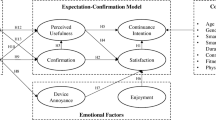Abstract
In this paper, we look at the user interface of a successful musical appliance. We discover that the user interface is difficult and inconsistent. The appliance is very hard to use, yet, people are willing to spend hundreds of hours learning it. This phenomenon cannot be wholly explained by saying that the experience of using the appliance is, in itself, enjoyable. My proposition (Heckel’s law) is that user interface design is not of primary importance as a factor in the adoption of an appliance.


Similar content being viewed by others
Notes
I may not be an appliance designer, but I do know something about the user interface of the bassoon.
It could be argued that the design is unsuccessful because not many people play the bassoon. But I believe that the main reason for the instrument’s relative scarcity is the high cost of buying a beginner instrument. In any case, my arguments apply to many other musical instruments.
There are several keys on my bassoon that I don’t use, and a couple whose purpose I have never discovered.
Try the following exercise: place your hands palm down on a table with the fingers resting on the table. For the starting position (F above middle C), lift the second finger (middle finger) of the left hand, the 3rd and 4th fingers of the right hand and both thumbs. For the second position (G—the next note in the scale), lift the little finger of the left hand with the first three fingers down and the index finger moved slightly closer to the middle finger; lift the two middle fingers of the right hand with the first and little finger down. Try alternating quickly between the two positions with all fingers moving at exactly the same time.
There are special fingerings for trills which do not produce ideal tone or pitch but which make it possible for the player to move their fingers fast enough.
I have removed the key lock on my instrument. I can put it back when I need it.
The dulcian, the renaissance predecessor to the bassoon, has a much more robust one-piece design, and could probably be used as a softball bat at a pinch.
This step in the start-up process can be eliminated by storing the reed in vodka. This also makes the reed taste nice.
There have been many attempts to improve the user interface of the bassoon by moving keys and holes around, but they have mostly had a detrimental effect on the quality of the sound.
I have seen an oboe with gold-plated keys—this is pretty, but it has no effect on the sound as far as I know.
References
1AD: the 1st international conference on appliance design (2003) Bristol, UK, 6–8 May 2003
21 Things that better appliances should be (2003) Appliance Studio (private communication)
Acknowledgements
Bassoon picture provided by Fox Products Corporation. Drawing by Gerard Hoffnung from The Hoffnung Symphony Orchestra, published by The Hoffnung Partnership, London, owners of the copyright. Reproduced by kind permission of Annetta Hoffnung.
Author information
Authors and Affiliations
Corresponding author
Rights and permissions
About this article
Cite this article
Derrett, N. Heckel’s law: conclusions from the user interface design of a music appliance—the bassoon. Pers Ubiquit Comput 8, 208–212 (2004). https://doi.org/10.1007/s00779-004-0279-6
Received:
Accepted:
Published:
Issue Date:
DOI: https://doi.org/10.1007/s00779-004-0279-6




